
Quezon City, also known as the City of Quezon and Q.C., is the most populous city in the Philippines. According to the 2020 census, it has a population of 2,960,048 people. It was founded on October 12, 1939, and was named after Manuel L. Quezon, the second president of the Philippines.

San Juan, officially the City of San Juan, is a 1st class highly urbanized city in the National Capital Region of the Philippines. According to the 2020 census, it has a population of 126,347 people. It is geographically located at Metro Manila's approximate center and is also the country's smallest city in terms of land area.

Santa Mesa is a district in Manila, Philippines. It is surrounded by the Pasig River on the southwestern side, and by the San Juan River on its southern and eastern side. Land borders include the districts of San Miguel to the west and Sampaloc to the north; and to the northeast is Quezon City.

V. Mapa station is an elevated Light Rail Transit (LRT) station located on the LRT Line 2 (LRT-2) system in Sampaloc, Manila. It is one of the four stations in the line with a reserve track nearby together with Santolan, Anonas and Araneta Center–Cubao. The station during its inception was formerly called as G. Araneta station but was renamed into the current name due to the minor realignment of some stations that has caused the change of proximity to the V. Mapa Street. The station serves the areas of Santa Mesa, Manila, Quezon City, and San Juan. The station is situated at Ramon Magsaysay Boulevard, near its intersection with Victorino Mapa Street in Santa Mesa, Manila.

The Metro Manila Skyway, officially the Metro Manila Skyway System (MMSS) or simply the Skyway, is an elevated highway serving as the main expressway of Metro Manila, Philippines. It connects the North and South Luzon Expressways with access to Ninoy Aquino International Airport via the NAIA Expressway (NAIAX). It is the first fully grade-separated highway in the Philippines and one of the longest elevated highways in the world, with a total length of approximately 39.2 kilometers (24.4 mi).

Radial Road 6 is the sixth radial road in Metro Manila, the Philippines. It passes through the cities of Manila, Quezon City, San Juan, Pasig, and Marikina, as well as Cainta, and Antipolo in the province of Rizal up to Santa Maria, Laguna and Infanta, Quezon

Circumferential Road 3 (C-3), informally known as the C-3 Road, is a network of roads and bridges that all together form the third beltway of Metro Manila in the Philippines. Spanning some 10.8 kilometers (6.7 mi), it connects the cities of Caloocan, Navotas, Quezon City, and San Juan.

The San Juan River is one of the main river systems in Metro Manila, Philippines, and is a major tributary of the Pasig River. It begins near La Mesa Dam as the San Francisco del Monte River, which officially takes the name San Juan River when it meets with Mariblo Creek in Quezon City. As the San Juan River, it passes through Quezon City, San Juan, the Manila district of Santa Mesa and Santa Ana, and Mandaluyong.

Manuel L. Quezon Avenue, more often called as Quezon Avenue, or simply Quezon Ave, is a 6.1-kilometer (3.8 mi) major thoroughfare in Metro Manila named after President Manuel Luis Quezon, the second president of the Philippines. The avenue starts at the Quezon Memorial Circle and runs through to the Welcome Rotonda near the boundary of Quezon City and Manila.

Aurora Boulevard is a four-to-ten lane major thoroughfare in Quezon City and San Juan in Metro Manila, Philippines. It was named after Doña Aurora Quezon, the consort of Commonwealth President Manuel Luis Quezon. It is one of the major roads in the commercial district of Araneta City in Cubao. Line 2 follows the alignment of the boulevard.

President Elpidio Quirino Avenue, more commonly known as Quirino Avenue, is a 6-10 lane divided highway in Manila, Philippines. It runs for 3.6 kilometers (2.2 mi) in a northeast–southwest direction from Nagtahan Bridge across from Santa Mesa in the north to Roxas Boulevard in Malate in the south. It passes through Paco and Pandacan districts where it also serves as a truck route between Port Area and South Luzon Expressway. North of Nagtahan Bridge, the road continues as Nagtahan Street. It is designated as part of Circumferential Road 2. It is named after Elpidio Quirino, the sixth President of the Philippines.

Ramon Magsaysay Boulevard, also known simply as Magsaysay Boulevard and formerly as Santa Mesa Boulevard, is the principal artery of Santa Mesa in Manila, Philippines. It is a six-lane divided roadway that travels east–west from Gregorio Araneta Avenue near the city's border with Quezon City and San Juan to Lacson Avenue and the Nagtahan Interchange, close to the district of San Miguel. The entire length of the boulevard serves as the district boundary between Sampaloc in the north and Santa Mesa in the south with the LRTA's Line 2 running along its median. East of Gregorio Araneta, the road continues as Aurora Boulevard while west of Lacson, it extends as Legarda Street via Legarda Flyover into San Miguel and Quiapo.

The San Juan River Bridge, also known as Pinaglabanan Bridge, San Juan del Monte Bridge, San Juan Bridge and the Old Santa Mesa Bridge, is a bridge that connects San Juan and Manila, spanning the San Juan River. The 46.85-meter (153.7 ft) bridge connects the N. Domingo Street in San Juan and Old Santa Mesa Street in Manila. The location of the bridge served as a battlefield during the 1896 Philippine Revolution against the Spaniards and the 1899 Philippine–American War.

The following is an alphabetical list of articles related to the Philippine capital region of Metro Manila.

Andres Bonifacio Avenue, also known as A. Bonifacio Avenue, is a 3.784-kilometer (2.351 mi) national secondary road connecting the North Luzon Expressway and Epifanio de los Santos Avenue at Balintawak Interchange in Quezon City and Blumentritt Road at the city's boundary with Manila in a north–south direction.

Santa Cruz often abbreviated as Sta. Cruz is a barangay located in the San Francisco Del Monte district of Quezon City with an approximate land area of 44 hectares bounded by South and West Triangles in the East, Quezon Avenue and Barangay Paligsahan in the South, Nayong Kanluran in the Northeast and Barangay Paltok in the North.

The Sucat–Paco–Araneta–Balintawak Transmission Line also known as Muntinlupa–Manila–Doña Imelda–Quezon Transmission Line, and formerly known as Sucat–Araneta–Balintawak Transmission Line from July 2000 to October 2012, is a 230,000 volt, single-circuit, three-part transmission line in Metro Manila, Philippines that connects Sucat and Balintawak substations of National Grid Corporation of the Philippines (NGCP), with line segment termination at NGCP Araneta substation in Quezon City and Manila Electric Company (Meralco) Paco substation in Paco, Manila.
National Route 180 (N180) is a secondary national route that forms part of the Philippine highway network, running from Cubao, Quezon City to Ermita, Manila.



















